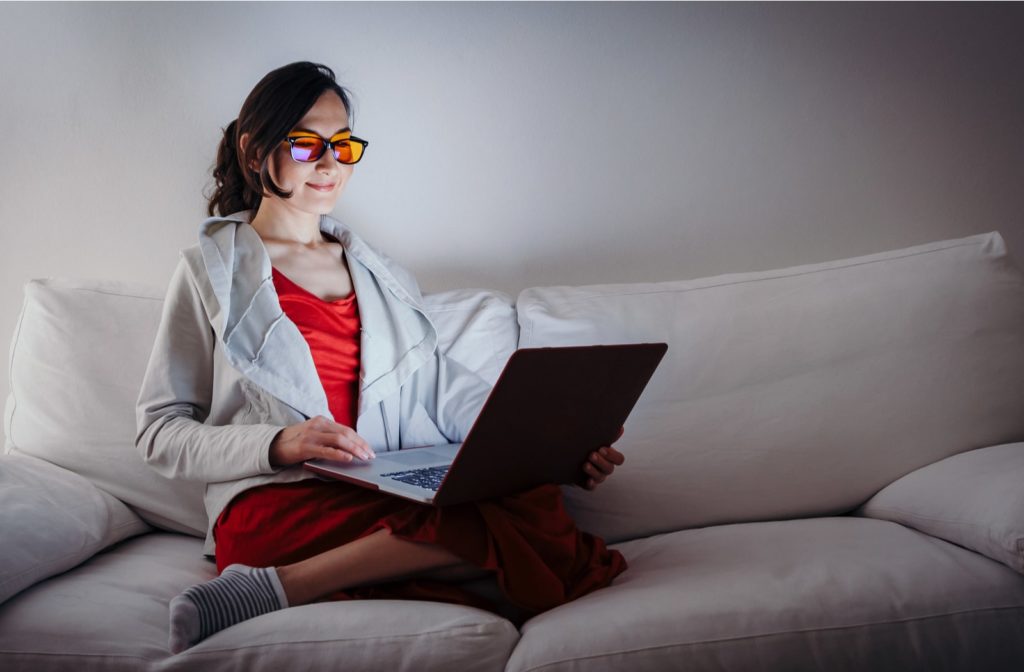Blue Light Protection for Contacts
Our eyes are consistently exposed to the elements, from dust to light waves. Although regular eye exams help you watch over your eye health, many lifestyle habits are crucial in protecting your vision. For example, you wear sunglasses to protect your eyes from sunlight, but what about eyewear for blue light protection?
You’ve likely heard about blue light or eyeglasses with a blue-light blocking finish. But what is blue light? Do you need blue light glasses if you wear contact lenses?
What Is Blue Light?
Blue light is part of the visible light spectrum. Every color of the visible light spectrum has unique qualities, including wavelength and energy. Blue light has higher energy levels and shorter wavelengths.
One step above blue light is ultraviolet light, which has even shorter wavelengths and higher energy levels, putting it out of visible light range. Although UV radiation has earned a reputation for impacts on eye health, blue light can be as significant without proper precautions.
We’re exposed to blue light every day. From artificial sources to natural sources, blue light is emitted almost everywhere. The sun is one of the most significant sources of blue light. Other blue light sources you likely use include:
- LED lights
- Smartphones
- LED TVs
- E-readers
- Tablet screens
- Computer monitors
- Fluorescent lights
Notably, digital sources of blue light are much weaker sources of blue light. Overexposure to blue light, like ultraviolet light, can be harmful to your eye health. However, overexposure is rare. The majority of blue light sources, even the sun, generally don’t emit enough blue light to cause damage.
Symptoms of Blue Light Exposure
The symptoms you experience may vary, as blue light overlaps with other factors related to overexposure from artificial blue light sources, namely digital screens. Notably, intense or prolonged exposure to blue light may cause digital eye strain. As research into the topic is still developing, it’s unclear if blue light or screen layout is the more significant contributor.
Another significant blue light topic is how it affects our sleep. Blue light helps our internal clock understand when to stay awake and when it’s time for bed. Nighttime exposure to blue light tricks our brains into thinking we should stay alert.
Digital Eye Strain
Digital eye strain is a group of eye and vision problems. The eye condition is typically associated with artificial blue light and is a primary concern for computer users. Digital eye strain can cause:
- Dry eyes
- Headaches
- Eye fatigue
- Blurry vision
- Neck pain
When we use digital devices, it affects how we blink, which interferes with our tear film. We blink to spread moisture over the surface of our eyes. When we blink less we’re more prone to developing dry eye.
Wearing contact lenses for long periods can also cause symptoms of dry eye. The combination of prolonged screen time and prolonged contact wear can create a perfect storm, contributing to worsening symptoms.
Do Contacts Block Blue Light?
Regular contact lenses don’t block blue light. But, like wearing regular contacts outdoors in the bright sunshine, your contacts can’t completely shield your eyes from harmful light rays.
But, there are more options than regular contact lenses. For example, many specialty contact lenses have convenient protective features, such as UV protection, glare reduction, or blue light blocking.
However, size does matter when blocking UV radiation and blue light. Most contact lenses cover the cornea, mainly the iris (colored part of the eyes).
Comparatively, eyeglasses and sunglasses have a larger surface area, allowing more surface area to prevent light from leaking through side angles. Notably, scleral lenses are a contact lens option with a larger surface area.
Do Contacts & Eyeglasses Mix?
Many contact wearers choose contact lenses to avoid wearing glasses, whether for convenience or aesthetics. However, contact lenses and eyeglasses have been known to work in tandem for many reasons.
For example, people with two vision issues, such as myopia and presbyopia, may wear contacts for distance vision but pop on their reading glasses for occasional close vision.
If you wear contact lenses, you can also wear blue-light-blocking glasses simultaneously. It can be handy if you don’t want to buy specialty contact lenses or you need a contact lens break during computer work.
As contact lenses can aggravate the symptoms of dry eye, taking a contact lens break can give your eyes a chance to recover. If digital eye strain is the cause of your dry eyes, you might momentarily replace your contacts with blue light glasses. A back-up pair of prescription eyeglasses with a blue-light coating can give your dry eyes relief and block blue light.
Finding the Best Fit
Sometimes finding the best fit for your eyes can be challenging. You might not know if wearing blue light glasses and contacts at the same time would feel comfortable for your unique eyes.
Visiting our optometrists can help you learn about your eye health. It’s also a chance for some trial and error. For example, see how our blue-light-blocking eyewear feels for your eyes.
If you’re ready for a pair of blue light eyeglasses or want to know more about your options, talk to the Eye Care Team. Book an appointment today!



